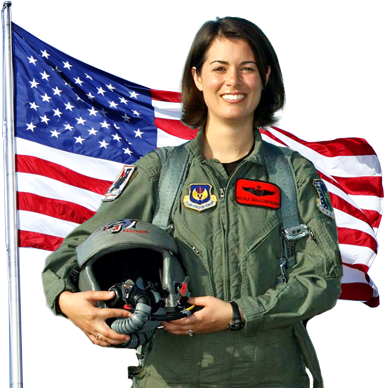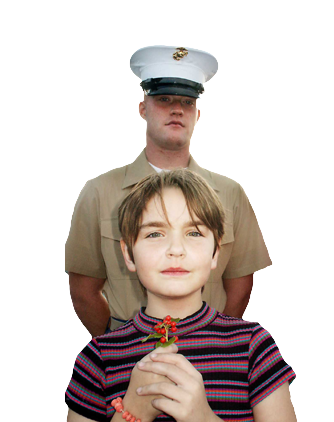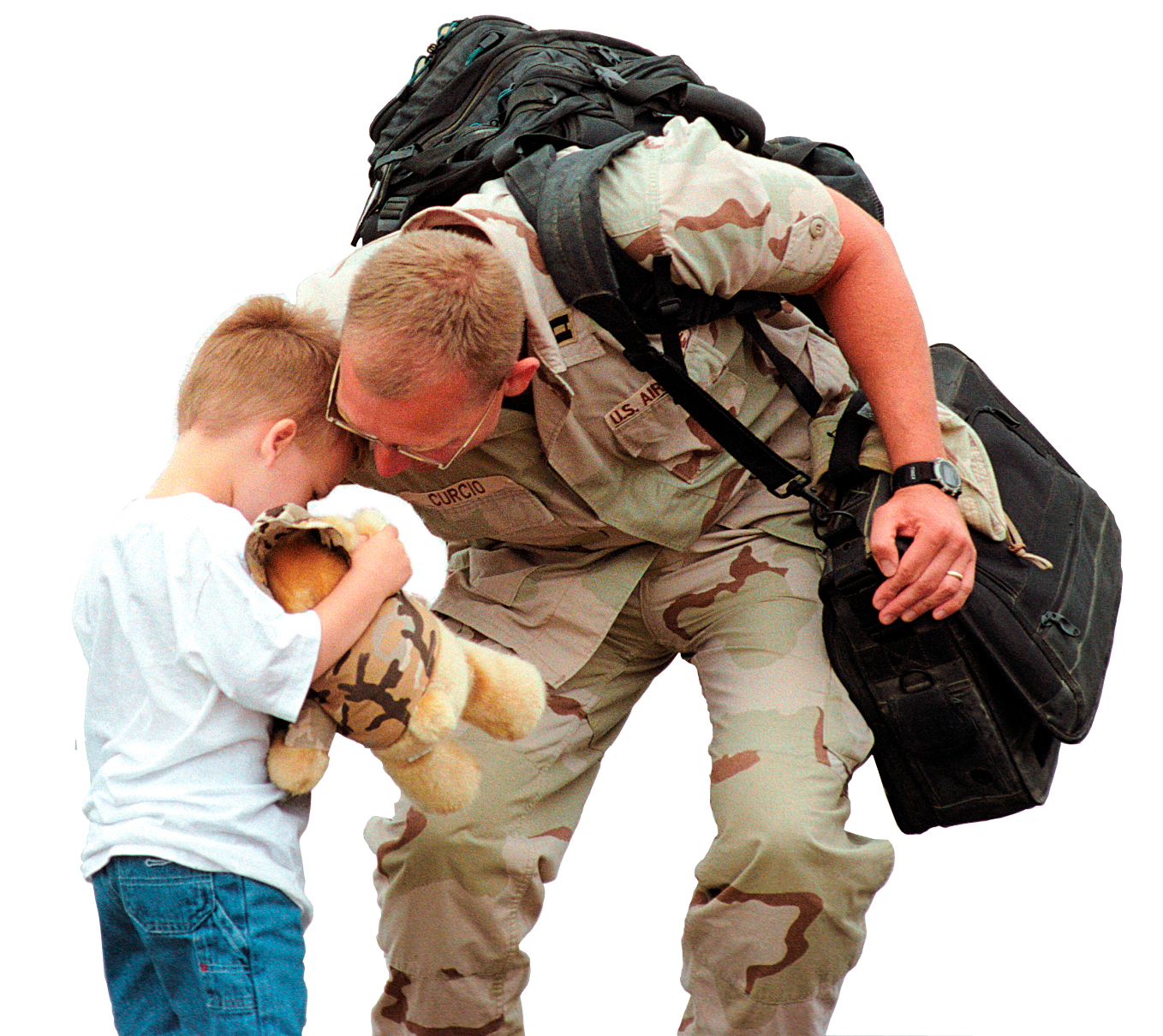Meet Your Military
- Details
- Hits: 3764
[caption id="attachment_3379" align="alignleft" width="298"] Army Pfc. Chelsea Draper poses with her grandfather, retired Marine Corps Sgt. Maj. Teddy Draper Sr., a decorated World War II veteran and a member of the famed Navajo “Code Talkers.â€Â Courtesy photo[/caption] WASHINGTON – Army Pfc. Chelsea Draper joined the Army, she said, to follow in the footsteps of her beloved grandfather, a decorated Marine Corps veteran of World War II.
Army Pfc. Chelsea Draper poses with her grandfather, retired Marine Corps Sgt. Maj. Teddy Draper Sr., a decorated World War II veteran and a member of the famed Navajo “Code Talkers.â€Â Courtesy photo[/caption] WASHINGTON – Army Pfc. Chelsea Draper joined the Army, she said, to follow in the footsteps of her beloved grandfather, a decorated Marine Corps veteran of World War II.
 Army Pfc. Chelsea Draper poses with her grandfather, retired Marine Corps Sgt. Maj. Teddy Draper Sr., a decorated World War II veteran and a member of the famed Navajo “Code Talkers.â€Â Courtesy photo[/caption] WASHINGTON – Army Pfc. Chelsea Draper joined the Army, she said, to follow in the footsteps of her beloved grandfather, a decorated Marine Corps veteran of World War II.
Army Pfc. Chelsea Draper poses with her grandfather, retired Marine Corps Sgt. Maj. Teddy Draper Sr., a decorated World War II veteran and a member of the famed Navajo “Code Talkers.â€Â Courtesy photo[/caption] WASHINGTON – Army Pfc. Chelsea Draper joined the Army, she said, to follow in the footsteps of her beloved grandfather, a decorated Marine Corps veteran of World War II.Serving here with Forward Support Command, 1st Battalion, 8th Infantry Regiment, 3rd Advise and Assist Brigade, 4th Infantry Division, Draper said her grandfather, Teddy Draper Sr., was one of the celebrated Navajo “Code Talkers.â€Â“Even at a young age, I could see the pride my grandfather took in having served his country, and I also understood the sacrifices he made,â€Â Draper said, noting she and her grandfather both hail from Chinle, Ariz.Code talkers transmitted coded messages over radio and telephone utilizing the Navajo language, or Diné Ke’Ji, which was undecipherable by the enemy. Draper said she grew up very close to her grandfather during her youth, having heard him recite stories of his military service. He retired as a sergeant major. During his career he’d received a Purple Heart, the Congressional Gold Medal, and his own personal Congressional Silver Medal, along with numerous other honors. “I miss her, and I worry about her,â€Â Draper Sr. said of his granddaughter. “But America needs its defenders.â€Â Draper said she has traveled a long way from the beautiful red-rocked mesas of Arizona to the golden sands of Iraq. Growing up on a reservation, she said she was raised, like her grandfather, within the culture of the Navajo people. “I speak and write in our native Navajo language in addition to English, following in a tradition our clan has kept alive as part of their heritage -- along with their religion, beliefs, legends and values,â€Â she said. When Draper was considering carrying on the family tradition of military service, she said her grandfather didn’t coax her at all. But when she told him she had decided to join the Army, she recalled how proud he was of her. “He gave me his full support, calling me ‘My Soldier,’â€Â she said. Sept. 30, 2010: By Army Spc. Jerry Ellis- 4th Infantry Division
- Details
- Hits: 2406
[caption id="attachment_3395" align="alignleft" width="286"] Marine Corps Pvt. Bernard D. Lueken, Platoon 3246, Company L, eats an apple after tackling an obstacle course during boot camp training at Edson Range, Marine Corps Base Camp Pendleton, Calif., Sept. 14, 2010. Lueken played college football for two years before he joined the Marine Corps. U.S. Marine Corps photo by Cpl. Rebecca A. Lamont[/caption] MARINE CORPS RECRUIT DEPOT SAN DIEGO – Marine Corps Pvt. Bernard D. Lueken said his departed mother’s military service and his inner voice caused him to give up a promising football career and enlist in the Marine Corps.
Marine Corps Pvt. Bernard D. Lueken, Platoon 3246, Company L, eats an apple after tackling an obstacle course during boot camp training at Edson Range, Marine Corps Base Camp Pendleton, Calif., Sept. 14, 2010. Lueken played college football for two years before he joined the Marine Corps. U.S. Marine Corps photo by Cpl. Rebecca A. Lamont[/caption] MARINE CORPS RECRUIT DEPOT SAN DIEGO – Marine Corps Pvt. Bernard D. Lueken said his departed mother’s military service and his inner voice caused him to give up a promising football career and enlist in the Marine Corps.
 Marine Corps Pvt. Bernard D. Lueken, Platoon 3246, Company L, eats an apple after tackling an obstacle course during boot camp training at Edson Range, Marine Corps Base Camp Pendleton, Calif., Sept. 14, 2010. Lueken played college football for two years before he joined the Marine Corps. U.S. Marine Corps photo by Cpl. Rebecca A. Lamont[/caption] MARINE CORPS RECRUIT DEPOT SAN DIEGO – Marine Corps Pvt. Bernard D. Lueken said his departed mother’s military service and his inner voice caused him to give up a promising football career and enlist in the Marine Corps.
Marine Corps Pvt. Bernard D. Lueken, Platoon 3246, Company L, eats an apple after tackling an obstacle course during boot camp training at Edson Range, Marine Corps Base Camp Pendleton, Calif., Sept. 14, 2010. Lueken played college football for two years before he joined the Marine Corps. U.S. Marine Corps photo by Cpl. Rebecca A. Lamont[/caption] MARINE CORPS RECRUIT DEPOT SAN DIEGO – Marine Corps Pvt. Bernard D. Lueken said his departed mother’s military service and his inner voice caused him to give up a promising football career and enlist in the Marine Corps.Lueken, 21, graduated from boot camp here, along with 482 other newly minted Marines, on Sept. 23. The St. Louis, Miss., native previously played football for four years as an offensive tackle at Chaminade College Preparatory School in Creve Coeur, Miss.“I tried out for the [Chaminade] football team as a freshman and was advised by the coach to pursue an athletic career in football,â€Â said Lueken, who later was awarded a full athletic scholarship to attend the University of Kansas in Lawrence, Kan. Lueken said he owes much to the strong character of his mother, who died of breast cancer seven years ago. She was one of the first women Marines to graduate from boot camp after it was designed to replicate men’s training, he said. She served six years in the Marines. “She would tell me, ‘Once a Marine, always a Marine,’â€Â Lueken recalled. “She taught me principles, traits and aspects of the Marine Corps like dedication, loyalty and to be good to the people around me.â€Â After his mother died, Lueken channeled his emotions and energy into sports. Lueken said he was “physically and mentally readyâ€Â to play college football at the University of Kansas, noting he played for the Jayhawks for nearly two years. The intensity and dedication required to play college football, he said, is similar to the intensity and dedication required for the Marine Corps. “There were many days we got up at 4 a.m. and would physically train, have film sessions where we studied the opponent, and position meetings, which are like small-unit meetings similar to having fire teams,â€Â Lueken said. “We would also take college classes, [and] have tutors for classes, which were required because we often wouldn’t be finished until 10 p.m.â€Â Despite his athletic accomplishments, Lueken said he eventually realized he didn’t want to be a football player. “I was playing at the highest level and I felt like I was wasting my time,â€Â Lueken said. “My years of youth could be spent for a better cause. I figured you only have your body and health once; I wanted to put it to good use.â€Â Lueken said he couldn’t ignore the fact that he was just playing a game. “The Marine Corps is not a game. It deals with real issues,â€Â he said. “College football is pure entertainment. It’s what people watch to get their minds off real-world issues.â€Â “Lueken understands the [Marine Corps] core values because he has known them all his life,â€Â said Staff Sgt. Levi K. Fajardo, senior drill instructor, Platoon 3246, Company L. “He had them in him when he got here. He came with a good foundation and he was well prepared.â€Â “What’s so appealing about the Marine Corps is that it’s a group of people that can get together and strive for a better cause,â€Â Lueken said. “I am a big believer in the ripple effect — you do something and it carries to another person.â€Â Lueken said he made the right choice by joining the Marines and doesn’t regret leaving football. “I don’t want to wake up one day and look back and say, ‘I wish I would have,’â€Â he said. Football “was exciting and fun, but we weren’t helping anyone.â€Â Sept. 28, 2010: By Marine Corps Cpl. Rebecca A. Lamont- Marine Corps Recruit Depot San Diego
- Details
- Hits: 2474
[caption id="attachment_3390" align="alignleft" width="300"] Army 2nd Lt. Aiana Janica Garin, left, a communications officer with Company B, Division Special Troops Battalion, 1st Armored Division, U.S. Division – Center, is promoted to first lieutenant by her father, Army Warrant Officer Romeo Garin, during a Sept. 19 ceremony at Camp Liberty, Iraq. U.S. Army photo by Cpl. Daniel Eddy[/caption] BAGHDAD – An Army father promoted his Army daughter during a Sept. 19 ceremony held at Camp Liberty here.
Army 2nd Lt. Aiana Janica Garin, left, a communications officer with Company B, Division Special Troops Battalion, 1st Armored Division, U.S. Division – Center, is promoted to first lieutenant by her father, Army Warrant Officer Romeo Garin, during a Sept. 19 ceremony at Camp Liberty, Iraq. U.S. Army photo by Cpl. Daniel Eddy[/caption] BAGHDAD – An Army father promoted his Army daughter during a Sept. 19 ceremony held at Camp Liberty here.
 Army 2nd Lt. Aiana Janica Garin, left, a communications officer with Company B, Division Special Troops Battalion, 1st Armored Division, U.S. Division – Center, is promoted to first lieutenant by her father, Army Warrant Officer Romeo Garin, during a Sept. 19 ceremony at Camp Liberty, Iraq. U.S. Army photo by Cpl. Daniel Eddy[/caption] BAGHDAD – An Army father promoted his Army daughter during a Sept. 19 ceremony held at Camp Liberty here.
Army 2nd Lt. Aiana Janica Garin, left, a communications officer with Company B, Division Special Troops Battalion, 1st Armored Division, U.S. Division – Center, is promoted to first lieutenant by her father, Army Warrant Officer Romeo Garin, during a Sept. 19 ceremony at Camp Liberty, Iraq. U.S. Army photo by Cpl. Daniel Eddy[/caption] BAGHDAD – An Army father promoted his Army daughter during a Sept. 19 ceremony held at Camp Liberty here.Army Warrant Officer Romeo Garin, a maintenance technician, promoted his daughter, Army 2nd Lt. Aiana Janica Garin, a communications officer with Company B of the 1st Armored Division’s special troops battalion, to first lieutenant in front of a group of fellow soldiers.“This is a great family affair,â€Â said Lt. Col. Lane Turner, the newly promoted lieutenant’s battalion commander. This is now-1st Lt. Garin’s first deployment to Iraq; her father had deployed with the 1st Armored Division in 2003 during Operation Iraqi Freedom. When she’d got word that her father would return to Iraq this July, she knew that she wanted him to promote her. “It’s a huge deal,â€Â Garin said of having her father promote her. “It means a lot to me to be serving under the same division as my dad. This is my first promotion and it was an honor.â€Â The father said he was very proud to have the chance to promote his daughter and that Army values helped him to raise her. “I can apply it to my kids on how to be successful in life and how to discipline yourself,â€Â he said. Even though father and daughter serve in the same division in Iraq, they are not in the same location. Garin is stationed at Camp Liberty while her father is stationed farther west at Camp Ramadi. Garin’s father was at Camp Liberty for a maintenance course and he was fortunate to have the dates coincide with his daughter’s promotion. Next year, Garin’s daughter will return the favor by promoting him to Chief Warrant Officer 2. Sept. 27, 2010: By Army Cpl. Daniel Eddy- 1st Armored Division
- Details
- Hits: 2245
[caption id="attachment_3400" align="alignleft" width="307"] Marine Corps Sgt. Kevin A. Aguilar conducts Marine Corps Martial Arts Program training with his Marines on a regular basis. In addition to his military occupational duties, Aguilar serves as a suicide prevention instructor trainer, Marine Corps Martial Arts Program instructor and Mentors in Violence Prevention instructor. U.S. Marine Corps photo by Cpl. Juan D. Alfonso[/caption] CAMP H.M. SMITH, Hawaii – Marine Corps Sgt. Kevin A. Aguilar has wanted to be a Marine almost for as long as he can remember.
Marine Corps Sgt. Kevin A. Aguilar conducts Marine Corps Martial Arts Program training with his Marines on a regular basis. In addition to his military occupational duties, Aguilar serves as a suicide prevention instructor trainer, Marine Corps Martial Arts Program instructor and Mentors in Violence Prevention instructor. U.S. Marine Corps photo by Cpl. Juan D. Alfonso[/caption] CAMP H.M. SMITH, Hawaii – Marine Corps Sgt. Kevin A. Aguilar has wanted to be a Marine almost for as long as he can remember.
 Marine Corps Sgt. Kevin A. Aguilar conducts Marine Corps Martial Arts Program training with his Marines on a regular basis. In addition to his military occupational duties, Aguilar serves as a suicide prevention instructor trainer, Marine Corps Martial Arts Program instructor and Mentors in Violence Prevention instructor. U.S. Marine Corps photo by Cpl. Juan D. Alfonso[/caption] CAMP H.M. SMITH, Hawaii – Marine Corps Sgt. Kevin A. Aguilar has wanted to be a Marine almost for as long as he can remember.
Marine Corps Sgt. Kevin A. Aguilar conducts Marine Corps Martial Arts Program training with his Marines on a regular basis. In addition to his military occupational duties, Aguilar serves as a suicide prevention instructor trainer, Marine Corps Martial Arts Program instructor and Mentors in Violence Prevention instructor. U.S. Marine Corps photo by Cpl. Juan D. Alfonso[/caption] CAMP H.M. SMITH, Hawaii – Marine Corps Sgt. Kevin A. Aguilar has wanted to be a Marine almost for as long as he can remember.I used to watch war movies instead of cartoons when I was a kid,â€Â the California native said. “When I was 7 years old, I saw a Marine color guard for the first time. They all looked so proud in their uniforms. Since then, my dream has always been to be a Marine.â€ÂHe planned to enlist after high school, he said, but life threw him a curve ball. At 18, with a child on the way, Aguilar decided being a father was more important than following his dream. But five years later, his family rewarded him for his dedication by bringing the Corps to him. “It was my wife who called the recruiter,â€Â he said. “At the time, I didn’t know they accepted anyone who wasn’t 18. I honestly thought I was too old to join. But my wife pushed me to follow my dream, and I signed up to be an infantryman.â€Â But the infantry was full at the time, and there was a nine-month wait before it would open again. Aguilar had to find an alternative. His recruiter suggested motor transportation, and Aguilar seized the opportunity to become a Marine. In January 2005, he shipped to basic training in San Diego, and then he attended Marine combat training. But once he arrived at his motor transportation school, Aguilar said, he was disappointed. “I thought I was going to be rolling around in … Humvees with .50 [caliber machine guns],â€Â he said. “When I found out I was going to be driving [5-ton trucks], I was not too happy.â€Â But Aguilar never forgot why he joined; he wanted to fight for his country. He graduated from his school and finally received the break he’d been waiting for. He was assigned to Marine Corps Air Ground Combat Center at Twentynine Palms, Calif. “They assigned me to 1st Tank Battalion,â€Â he said. “It was a combat unit. I automatically took a lot of pride in that. It was what I joined for. I was overjoyed my dream was coming true.â€Â Aguilar deployed to Iraq in 2007, but in the interim, he said, he needed to challenge himself. During a time when many Marines weren’t interested in the Marine Corps Martial Arts Program, Aguilar took it upon himself to become a martial arts instructor in 2006. “I have a saying: ‘Do something challenging at least once a year,’â€Â he said. “In 2005, that was boot camp. I deployed to Iraq in 2007. So in 2006, I saw that the battalion only had one [martial arts] instructor. So I chose to become one myself. It challenged me to be physically fit. I became more confident, and I trained dozens of Marines. I loved it.â€Â During his time in Iraq, Aguilar and his platoon conducted dozens of combat missions, and the young Marine and earned a reputation for being trustworthy and dependable. His reputation followed him back to Twentynine Palms. In October 2008, Aguilar was promoted to his current rank and was made a convoy leader for an exercise. Challenged with a position typically reserved for staff noncommissioned officers and senior sergeants, Aguilar proved his worth by conducting the 30-day exercise with zero incidents while in charge of more than 80 Marines. Two months later, he was transferred to Hawaii and assigned to Headquarters and Service Battalion, Marine Forces Pacific, to work as the dispatching and licensing noncommissioned officer in charge. Aguilar said he realized he was being sent to a nondeployable unit, but that he took the assignment to give back to those who gave up so much for his dream. “I look at it as a little payback to my family,â€Â Aguilar said. “They gave up a lot so I could be a Marine. They put up with me being gone for training, a combat tour, exercises, you name it. I got to bring them out to Hawaii for everything they’ve done for me.â€Â Despite his “desk job,â€Â Aguilar is far from complacent. He mentors his Marines, is active in their lives and continues to serve as a martial arts instructor. “He’s a stellar sergeant of Marines,â€Â said Cpl. James Moore, a motor transportation Marine. “I’ve been in for almost five and a half years. I’ve seen my fair share of sergeants who just go through the motions, but I know that I can take a problem to Sergeant Aguilar and guarantee that it gets done.â€Â. Moore recalled an example of Aguilar’s leadership. “I had to go on emergency leave once, and I couldn’t find the number to the Red Cross,â€Â he said. “Five seconds after I told him, he had the number for me. That’s the kind of sergeant he is.â€Â. Aguilar’s dependability has been noticed throughout the command. In addition to his job and the time he puts in as an instructor, the command has given him additional duties reserved for only the most mature and dependable Marines: suicide prevention instructor trainer and Mentors in Violence Prevention instructor.. “He’s an extremely dependable sergeant,â€Â said Marine Corps Staff Sgt. Trinity A. Lizalde, battalion embark chief. “It’s just Aguilar. If you work with him, you know things are going to get done. He’s exactly what a sergeant of Marines should be.â€Â. Aguilar and his family are scheduled to leave Hawaii in December. He hopes to become a drill instructor.. “The next couple of years aren’t going to be a vacation,â€Â he said. “But it’s time I give back to the Marine Corps for what it’s given me.â€Â Sept. 23, 2010: By Marine Corps Cpl. Juan D. Alfonso- Marine Forces Pacific
- Details
- Hits: 2914
[caption id="attachment_3405" align="alignleft" width="300"] Michael Verton, a process improvement specialist at Tobyhanna Army Depot, Pa., served as a soldier in Iraq and Afghanistan. Courtesy photo[/caption] TOBYHANNA ARMY DEPOT, Pa. – As Michael Verton helps employees here work more efficiently, it's hard to imagine that this cheerful, fun-loving and very young-looking "kid" was a full-time warfighter only a short while ago.
Michael Verton, a process improvement specialist at Tobyhanna Army Depot, Pa., served as a soldier in Iraq and Afghanistan. Courtesy photo[/caption] TOBYHANNA ARMY DEPOT, Pa. – As Michael Verton helps employees here work more efficiently, it's hard to imagine that this cheerful, fun-loving and very young-looking "kid" was a full-time warfighter only a short while ago.
 Michael Verton, a process improvement specialist at Tobyhanna Army Depot, Pa., served as a soldier in Iraq and Afghanistan. Courtesy photo[/caption] TOBYHANNA ARMY DEPOT, Pa. – As Michael Verton helps employees here work more efficiently, it's hard to imagine that this cheerful, fun-loving and very young-looking "kid" was a full-time warfighter only a short while ago.
Michael Verton, a process improvement specialist at Tobyhanna Army Depot, Pa., served as a soldier in Iraq and Afghanistan. Courtesy photo[/caption] TOBYHANNA ARMY DEPOT, Pa. – As Michael Verton helps employees here work more efficiently, it's hard to imagine that this cheerful, fun-loving and very young-looking "kid" was a full-time warfighter only a short while ago.A combat injury in July 2008 ended Verton's career as a soldier, but not his desire to serve his country. As a process improvement specialist here, he's able to help employees save time and money by streamlining business practices that have a direct effect on the warfighter.Verton grew up in the small town of Lake Ariel, Pa. Following high school, he earned a degree in psychology and took a job working with autistic children. But Sept. 11, 2001, changed everything. Even before he went to speak to an Army recruiter, he said, he knew he was going to join the ranks of the 82nd Airborne Division as an infantry soldier. He served in Iraq from 2005 to 2006 and in Afghanistan from 2007 to 2008. While there, he said, he used and depended on equipment repaired by depot employees. "Serving with my brothers in arms has brought more pride to me than nearly anything else in my life,â€Â Verton said. “I truly was able to serve with America's heroes. Working here makes it feel as though I'm serving with my brother, who is deployed to Afghanistan, and my unit, which is also deployed." Verton works with a team of specialists who support the communications systems directorate, which repairs combat radios and other equipment he used while deployed. "His ability and insight as a former customer and now as a challenge solver enables him to express new concepts and ideas that lead to positive outcomes for our employees and to the organization," said Tony Rubin, chief of the communications security division. Verton helps to return equipment in a timely and cost-effective manner to warfighters in the field. "The soldiers depend on Tobyhanna -- I depended on Tobyhanna -- to provide quality, working equipment and get it to us in a timely manner," Verton said. Tobyhanna Army Depot is the Defense Department's largest center for the repair, overhaul and fabrication of a wide variety of electronics systems and components, from tactical field radios to the ground terminals for the defense satellite communications network. Tobyhanna's missions support all branches of the armed forces. Sept. 22, 2010: By Mary Ostroski- Tobyhanna Army Depot






